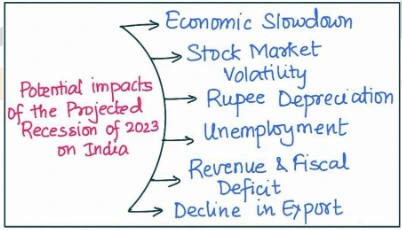Answer:
|
How to approach the question
- Introduction
- Define recession and write about the projected recession of 2023 briefly.
- Body
- Write the potential impacts of the projected recession of 2023 on India.
- Write the Takeaway from the 1991 LPG reforms in this regard.
- Write the necessary modifications to mitigate the impact of the recession.
- Conclusion
- Give appropriate conclusion in this regard.
|
Answer Introduction
A recession is a significant, widespread, and prolonged downturn in economic activity. A common rule for declaring a recession is when two consecutive quarters witness negative GDP growth.
The projected recession of 2023 is a global economic slowdown that is expected to begin in the second half of the year. The recession is being caused by a number of factors, including rising inflation, interest rates, and supply chain disruptions. The recession is expected to have a significant impact on the global economy, including India.
Body
Potential impacts of the projected recession of 2023 on India
- Economic Slowdown: India, being part of the global economy, could face significant economic slowdown. This could mirror the 2008 recession, where India’s GDP growth dropped from 9.3% in 2007-08 to 6.7% in 2008-09.
- Stock Market Volatility: The 2023 recession may lead to substantial volatility in the Indian stock markets. A parallel can be drawn to the 2008 recession, when the BSE Sensex dropped by about 50%.
- Rupee Depreciation: The global recession may lead to the depreciation of the rupee against major currencies due to capital outflows, much like in 2013, when fears of U.S. Federal Reserve tapering led to significant rupee depreciation.
- Unemployment: Job losses might rise significantly, especially in sectors dependent on global demand such as IT, automobiles, and textiles. Similar to the pandemic-led recession in 2020 which saw unemployment spike to over 23%.
- Government Revenues and Fiscal Deficit: Government revenues might fall due to lower tax collections, and with increased public spending to stimulate the economy, the fiscal deficit might widen. Similar situations arose post the 2008 recession and the 2020 COVID-19-induced recession.
- Export Decline: India, being a major exporter of goods and services, could see a fall in exports due to decreased global demand, reminiscent of the 15% fall in exports in 2009 after the global financial crisis.
Takeaway from the 1991 LPG reforms in this regard
- Adapting to Globalization: These reforms highlight the importance of integrating the Indian economy with the global market leading to increased FDI and exports. In a post-recession world, opening up new sectors to foreign investments can stimulate economic recovery.
- Fiscal Prudence: The 1991 crisis was triggered by fiscal indiscipline. It is imperative for the government to manage public finances efficiently during a recession, avoiding excessive borrowing while targeting expenditure towards economic revival and social security.
 Financial Sector Reforms: The establishment of regulatory bodies like SEBI post-1991 reforms helped maintain market integrity. In a volatile recession-hit economy, strengthening financial regulations can prevent fraudulent practices and maintain investor confidence.
Financial Sector Reforms: The establishment of regulatory bodies like SEBI post-1991 reforms helped maintain market integrity. In a volatile recession-hit economy, strengthening financial regulations can prevent fraudulent practices and maintain investor confidence.- Diversification of Economy: Post 1991, India transitioned from being a predominantly agriculture-based economy to a diversified one. The 2023 recession could be a cue to further diversify into new- age sectors like green energy, AI, and blockchain technologies.
- Building Forex Reserves: The 1991 crisis was caused by a balance of payments crisis and a near- depletion of forex reserves. The 2023 recession serves as a reminder to maintain adequate forex reserves as a buffer against external shocks.
Necessary modifications to mitigate the impact of the recession can be
- Fiscal Stimulus: The government could introduce a fiscal stimulus package, akin to the ‘Atmanirbhar Bharat’ package unveiled during the COVID-19 pandemic, aimed at boosting demand through tax cuts and increased public expenditure.
- Monetary Policy: The Reserve Bank of India (RBI) could use the tool of interest rate cuts, as it did during the 2008 financial crisis, to make borrowing cheaper, stimulate investment, and revive the economy.
- Reform Labor Laws: The government can revisit labor laws to make them more flexible. Rajasthan’s labor law reforms of 2014, which relaxed several restrictive regulations, led to increased formal sector employment, offering a model that could be emulated.
- Infrastructure Investment: Accelerating projects under the National Infrastructure Pipeline (NIP) can spur job creation and economic growth, following the examples of countries like China and Japan that used infrastructure investment for post-recession recovery.
- Promotion of Digital Economy: Fostering further digitalization in sectors such as finance, healthcare, and education can spur innovation and efficiency. The government’s Digital India initiative has already made significant strides in this direction.
- Attracting Foreign Investment: Relaxing foreign direct investment (FDI) norms in sectors like multi-brand retail, education, and healthcare can pull in more overseas capital. Progressive reforms like the 100% FDI under automatic route in the coal sector in 2020 serve as examples.
Conclusion:
The 2023 recession presents significant challenges for India, but it also provides opportunities for comprehensive economic reforms. Drawing lessons from the past and implementation of above strategies can mitigate impacts and drive recovery laying the foundation for a stronger and more resilient economy.
To get PDF version, Please click on "Print PDF" button.
 Financial Sector Reforms: The establishment of regulatory bodies like SEBI post-1991 reforms helped maintain market integrity. In a volatile recession-hit economy, strengthening financial regulations can prevent fraudulent practices and maintain investor confidence.
Financial Sector Reforms: The establishment of regulatory bodies like SEBI post-1991 reforms helped maintain market integrity. In a volatile recession-hit economy, strengthening financial regulations can prevent fraudulent practices and maintain investor confidence.
Latest Comments